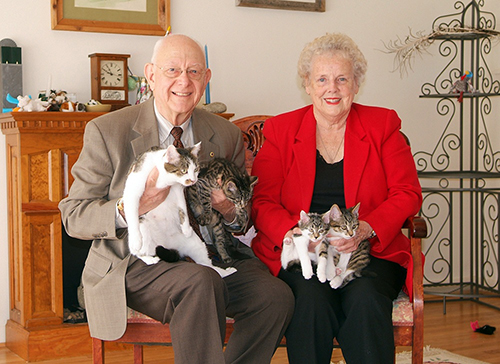Texas A&M Says Goodbye to CC, World’s First Cloned Cat
Story by Megan Myers, CVMBS Communications

CC, the world’s first cloned cat, has passed away at the age of 18, after being diagnosed with kidney failure.
CC, short for Copy Cat, passed away on March 3 in College Station, the same place where her life began as a result of groundbreaking cloning work done by Texas A&M College of Veterinary Medicine & Biomedical Sciences (CVM) researchers.
CC was born on Dec. 22, 2001, and was adopted by Dr. Duane Kraemer, a senior professor in the college’s Reproduction Sciences Laboratory, and his wife, Shirley, six months after her birth.
“We in the CVM are saddened by the passing of CC. As the first cloned cat, CC advanced science by helping all in the scientific community understand that cloning can be effective in producing a healthy animal,” said Dr. Eleanor M. Green, the Carl B. King dean of Veterinary Medicine at Texas A&M.
“While she lived a long, normal, and happy life, CC was extraordinary in what she represented to the Kraemers, the CVM, and science as a whole,” Green said. “The entire CVM community mourns her loss, as all at Texas A&M cared deeply about her as a member of the Aggie family, and especially for the Kraemers, for whom CC was a beloved pet for 18 years.”
CC’s story began with Dr. Mark Westhusin, a CVM professor and the principal investigator of the Missyplicity Project, a $3.7 million effort to clone a mixed-breed dog named Missy that was owned by John Sperling, founder of the University of Phoenix.
When the news of this project spread, people around the country became interested in saving pets’ tissues that could possibly be used for cloning in the future. This demand resulted in the establishment of Genetic Savings and Clone (GSC), Inc., led by Sperling’s colleague Lou Hawthorne and Dr. Charles Long.
While GSC became a bank for these tissues, Westhusin and his team at Texas A&M began to explore the cloning of other pet species, specifically cats.
CC was produced using nuclear transfer of DNA from cells that were derived from a female domestic shorthair named Rainbow.

Once it was clear the nuclear transfer was successful, Kraemer and other scientists transferred the embryos into a surrogate mother, who gave birth to a healthy kitten about two months later.
Though the cats were identical on a genetic level, developmental factors led them to have slightly different coat patterns and color distributions.
“CC was the biggest story out of A&M ever and still is, as far as international reach is concerned,” Kraemer said. “Every paper and magazine had pictures of her in it. She was one of the biggest accomplishments of my career.”
“CC’s passing makes me reflect on my own life as much as hers,” Westhusin said. “Cloning now is becoming so common, but it was incredible when it was beginning. Our work with CC was an important seed to plant to keep the science and the ideas and imagination moving forward.”
CC also became one of the first cloned cats to become a mother—when CC was 5 years old, she gave birth to three kittens that lived with CC for the rest of her life in a custom, two-story “cat house” in the Kraemers’ backyard.
While CC represented a great advancement in genetic research, to the Kraemers, she was also a beloved pet. She will be missed by them, especially, but also by those at the CVM, Texas A&M, and beyond who have followed her story since birth.
“CC was a great cat and a real joy,” Kraemer said. “She was part of the family and very special to us. We will miss her every day.”

Throughout her lifetime, CC regularly made news for her birth, pregnancy, and each birthday. She proved to the world that cloned animals can live the same full, healthy lives as non-cloned animals, including being able to produce healthy offspring.
Before CC, no pet had ever been successfully cloned with 100 percent genetic identity.
The research that led to CC’s birth kickstarted a global pet cloning industry led by ViaGen Pets, which today clones cats for $35,000 and dogs for $50,000.
Though CC was the first successfully cloned pet, Texas A&M has gone on to clone more species than any other institution in the world, including horses, pigs, goats, cattle, and deer.
###
For more information about the Texas A&M College of Veterinary Medicine & Biomedical Sciences, please visit our website at vetmed.tamu.edu or join us on Facebook, Instagram, and Twitter.
Contact Information: Jennifer Gauntt, Director of Communications, Texas A&M College of Veterinary Medicine & Biomedical Sciences; jgauntt@cvm.tamu.edu; 979-862-4216


